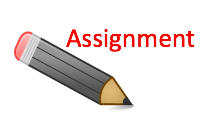 Assessment Summary PowerPoint
Assessment Summary PowerPoint
- FEAP: 1.EV.3, 4.EV.2, 4.EV.3, 5.EV.1, 5.EV.2
- ESOL Standards: 4.1.c, 5.1.a, 5.3.b
- ESOL C&S: 10.1, 11.1, 11.2
- PEC: 1.1, 1.10, 4.4, 4.5, 4.6, 5.3, 5.5
- UCC: d
- TPI: 2.1
50 points
Upon completion of a lesson plan that has been implemented within EDU 4400, the teacher candidate will practice analyzing, interpreting with assistance, and evaluating a variety of formative and summative performance based assessments with the assistance of the cooperating teacher that aligns with standards based instruction to monitor student progress, mastery, and learning gains.
The teacher candidate will collaborate with colleagues on the data collected from a variety of sources and use data-informed research to assist in evaluating learning outcomes and adjust instruction as needed to continuously improve instruction.
The assessment data will be presented using a PowerPoint which includes:
Create your presentation in your own words. Be creative with your presentation. Don't be wordy-- use bullets and chunk information . Use your own words to explain it. Organize your information.
|
LEVEL III Assessment Analysis
Three part Powerpoint
|
| |
- Formative and diagnostic assessments and strategies to monitor student learning
|
- Development of formative and summative assessments
|
- Evaluating students strengths and weaknesses
|
- Interpret student assessment data with the use of technology
|
- Personal improvement and professional goals
|
- Data-informed research to assist in evaluating learning outcomes
|
- Evaluating and assessing
|
About your PowerPoint presentation
Your presentation should be clean, free of errors, attractive, and have a header with what is required for each slide. Insert a footer with your name and class. You will save as a PDF to upload. You may work together on slides 1-5 but slides 6-10 should focus on your specific classroom. Use the rubric.
Slide 0 TITLE PAGE, your name, class/grade, table of contents
PART 1: Your assigned school (school-wide data) (You may work with other field study students at your school)
- Slide 1– background on your school, demographics, school grade
- Slide 2 - PCSB testing calendar, explain how the calendar affects your students, what is expected of them, explain the purpose FSA, ramifications of assessment results
- Slide 3 What types of assessments used at your school (schoolwide) to monitor student progress, mastery, learning gains (describe each test and purpose)
- Slide 4 - Identify appropriate uses of alternative assessments (e.g. authentic, performance-based, peer- and self-assessments) as well as measurement concepts (e.g. reliability, validity), test characteristics, and uses of norm-referenced and criterion-referenced assessments to evaluate content area learning
PART 2: Your classroom (work with your CT on this section)
Slide 5 – ELL students -
- Classroom demographics
- how do you identify factors such as cultural and linguistic bias that affect the assessment of ELLs?
- How do you determine appropriate accommodations, modifications of classroom tests, including test items and tasks, during formal and informal assessments for ELLs at varying English proficiency levels?
Slide 6 -Types of Classroom Assessments
describe what formative and diagnostic assessments are used with your students. What is their purpose? analyze and explain how data from selected formative and diagnostic assessments are effective in monitoring and planning for student learning.
- Example: Istation, STAR, AR
Slide 7 –Monitoring student progress
- How do you monitor student progress? Is it ongoing?
- How do you analyze and evaluate the student’s strengths and weaknesses based on data?
- How do you monitor mastery and learning gains? How do you apply appropriate intervention strategies? Give specific examples.
Slide 8 -Collaboration with Peers
How do you collaborate with colleagues to review data to assist in evaluating learning outcomes and adjust instruction as needed? Group students? Plan, adjust instruction? Show examples of student data or how you use it to group students
Slide 9 Address these questions…
- How do you keep parents informed of student’s progress?
- What about parent conferences?
- Data nights or parent workshops?
- How do you prepare students for testing?
- How do you keep parents informed of the curriculum?
Part 3: Reflection from your three lessons
Slide 11-13: Formative and Summative Assessments
- Slide 11 - Lesson 1
- Slide 12 - Lesson 2
- Slide 13- Lesson 3
|
Lesson #
|
|
|
Standard
|
|
|
Objective
|
|
|
Formative
|
|
|
Summative
|
|
|
Data
|
|
|
What did it tell you?
|
|
|
How do you know if student’s master the lesson objective
|
|
|
How will this data drive your instruction?
|
|
Slide 14:
- How does your reflecting your instruction support your personal continuous improvement and professional goals?
- How does data drive your instruction?